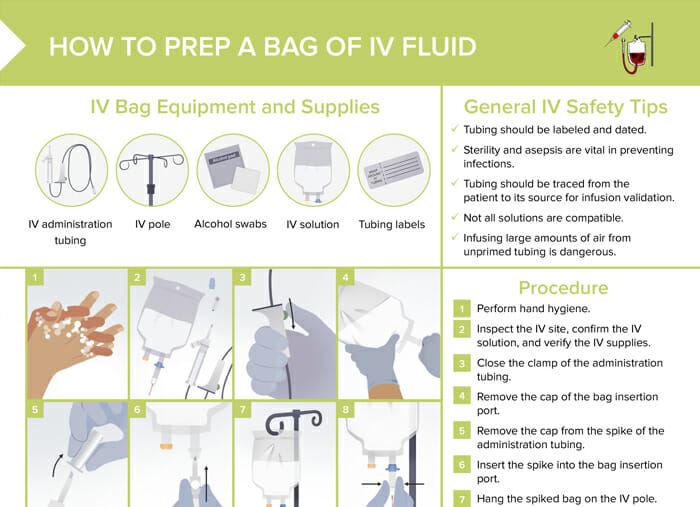What is an IV piggyback?
An IV piggyback, also known as an IVPB or secondary infusion, is a method of administering medication through an intravenous (IV) line. It involves attaching a smaller bag of medication to the primary IV line and allowing it to infuse intermittently. The primary bag contains maintenance fluids or flush, while the secondary bag contains the medication that needs to be administered.
This method is commonly used when multiple medications need to be administered through the same IV line. The use of an IV piggyback can help reduce the risk of infection and minimize the number of needle sticks required for clients who require multiple medications.
How is an IV piggyback different from a regular IV line?
A regular IV line typically administers fluids like saline solution, electrolytes or nutrients directly into a patient’s bloodstream. An IV piggyback is used to deliver medications into the primary IV line, “piggybacking” off the existing setup. It therefore allows medications to be administered without interruption of the primary IV fluids.
What supplies are needed to hang an IV piggyback?
The supplies needed include:
- Primary and secondary tubing
- Primary and secondary fluid or medication bag
- IV pole
- Medication pump
- Alcohol pads
- Clean gloves
What is the procedure for hanging an IV piggyback?
- Check that secondary medication and primary medication are compatible.
- Wash hands and apply clean gloves.
- Ensure the client’s IV is properly functioning by inspecting the IV site and flushing it with saline (not needed if the client has a “main IV‘ infusing).
- Close the roller clamp of the secondary tubing.
- Spike the secondary fluid bag with the 2° tubing and prime tubing with secondary bag fluid.
- Hang the primary fluid bag below secondary.
- Scrub the injection port of the primary tubing—this is above the medication pump.
- Connect the secondary tubing to the primary tubing.
- Program the pump, double check that the rate is correct for each medication being administered through a piggyback line.
Please note that these instructions are specific to an IV pump and re-priming for amount of fluid and length of time for intermittent infusion, so practices may vary depending on facility or institution policies.
Related videos
How do I calculate the drip rate for an IV piggyback?
Drip rate can be calculated using the following formula: total volume (in mL) x drop factor (gtts/mL) / time (in minutes). The drop factor would be available on the IV tubing package.
What is back priming and why might it not be allowed in some facilities?
Back priming involves using one secondary tubing for multiple secondary infusions of different types. Depending on facility or institution policies, this practice might not be allowed, because it can increase the risk of contamination and infection if not done properly. Additionally, some medications may interact with each other or cause adverse reactions if administered through the same tubing. Always follow facility-specific policies and guidelines to ensure safe and effective medication administration.
What are some clinical tips for administering multiple IV medications?
- Use an extension hook to keep multiple medications on one line to reduce infection risk.
- Always follow the “Five Rights” to check medication and orders.
What are the “Five Rights” for checking medication and orders?
The “Five Rights” of medication are a set of guidelines that healthcare professionals follow to ensure safe and accurate medication administration. The five rights are:
- Right patient: Ensuring that the medication is being given to the correct patient.
- Right drug: Ensuring that the correct medication is being given.
- Right dose: Ensuring that the correct amount of medication is being given.
- Right route: Ensuring that the medication is being given through the correct route (e.g., oral, intravenous, etc.).
- Right time: Ensuring that the medication is being given at the correct time.
Some new textbooks now list seven “Rights”:
6. Right documentation: Ensuring medications are documented correctly when administering and double-checking existing documentation.
7. Right indication: Ensuring the medication is the adequate choice for the situation.
Following these guidelines helps to minimize errors and ensure safe and effective medication administration.
Are there any specific precautions to take when administering a secondary medication through an IV piggyback?
- Close the roller clamp of the secondary tubing before spiking it with a new fluid bag to prevent rapid flow out of the tube.
- Double-check that the rate is correct for each medication being administered through a piggyback line.
What are some common complications with IV piggyback infusions?
Complications can include medication errors, infiltration, extravasation, phlebitis, air embolism, or infection. To address these issues, double-check medications and doses, monitor the IV site closely for signs of complications, and ensure that all equipment is used correctly and sterilely. In case of any adverse events, immediately stop the infusion, disconnect the IV line, and alert the health care provider.
How is an occlusion (blockage) addressed in the piggyback line?
Firstly, try to gently flush the line with a compatible IV solution. If the blockage still remains, you may need to discontinue the IV piggyback and set up a new one. Never try to force fluid into a blocked IV line.

